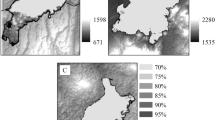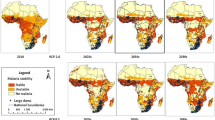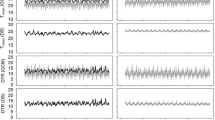Abstract
Promising environmental mechanisms to control malaria are presently underutilized. Water level fluctuations to interrupt larval development have recently been studied and proposed as a low-impact malaria intervention in Ethiopia. One impediment to implementing such new environmental policies is the uncertain impact of climate change on water resources, which could upend reservoir operation policies. Here we quantified the potential impact of the malaria management under future climate states. Simulated time-series were constructed by resampling historical precipitation, temperature, and evaporation data (1994–2002), imposing a 2 °C temperature increase and precipitation changes with a range of ±20 %. Runoff was generated for each climate scenario using the model GR4J. The runoff was used as input into a calibrated HEC ResSim model of reservoir operations. The malaria operation management increased the baseline scenario median energy generation by 18.2 GWh y−1 and decreased the energy generation at the 0.5 percentile (during dry conditions) by 7.3 GWh y−1. In scenarios with −20 % precipitation, malaria control increased average annual energy generation by 1.3 GWh y−1 but only decreased the lowest 0.5 percentile of energy by 0.2 GWh y−1; the irrigation demand was not met on 8.5 more days, on average, per year. Applying the malaria control rule to scenarios with +20 % precipitation decreased the likelihood of flooding by an average of 1.0 day per year. While the malaria control would divert some water away from other reservoir operational goals, the intervention requires 3.3–3.7 % of the annual precipitation budget, which is much less than reduction from potential droughts.





Similar content being viewed by others
References
Africa Progress Report (2015), Power, people, planet: seizing Africa’s energy and climate opportunities. Africa Progress Panel, 182 pp
Akele, S.T. (2011), The practice and challenges of lake management in Ethiopia—the case of Lake Koka, master of science thesis in environmental science. Swedish University of Agricultural Sciences, Slu, Uppsala, Sweden
Alsop Z (2007) Malaria returns to Kenya’s highlands as temperatures rise. Lancet 370(9591):925–926
Atangana S, Foumbi J, Charlois M, Ambroise-Thomas P, Ripert C (1979) Epidemiological study of onchocerciasis and malaria in Bamendjin dam area (Cameroon). Med Trop 39(5):537–543
Block PJ, Souza Filho FA, Sun L, Kwon H-H (2009) A streamflow forecasting framework using multiple climate and hydrological models. JAWRA J Am Water Resour Assoc 45(4):828–843
Burn DH, Simonovic SP (1996) Sensitivity of reservoir operation performance to climatic change. Water Resour Manag 10(6):463–478
Chaves LF, Koenraadt CJM (2010) Climate change and highland malaria: fresh air for a hot debate. Q Rev Biol 85(1):27–55
Christensen NS, Wood AW, Voisin N, Lettenmaier DP, Palmer RN (2004) The effects of climate change on the hydrology and water resources of the Colorado River Basin. Clim Chang 62(1–3):337–363
Conway D, Schipper ELF (2011) Adaptation to climate change in Africa: challenges and opportunities identified from Ethiopia. Glob Environ Chang 21(1):227–237
de Wit M, Stankiewicz J (2006) Changes in surface water supply across Africa with predicted climate change. Sci 311(5769):1917–1921
EEPCo (2002) Koka Dam sedimentation study: recommendations report, Addis Ababa
EEPCo (2014) Koka power station description; Facts about Hydro Electric Power, http://www.eepco.gov.et
EEPCo (Ethiopian Electrical Power Corporation) (2008) Data was provided upon request, Addis Ababa
Ejeta MZ, Biftu GF, Fanta DA (2009) Upper awash river system in Ethiopia. In: Mays LW (ed) Integrated urban water management in arid and semi-arid regions. UNESCO, Paris
Fosler-Lussier E (1998) Markov models and hidden Markov Models: a brief tutorial. International Computer Science Institute, Berkeley
Getachew, Z. (2014), Ethiopia: Kessem Irrigation Dam nears completion. All Africa; Ethiopian Radio and Television Agency, June 12, 2014
Gething PW, Smith DL, Patil AP, Tatem AJ, Snow RW, Hay SI (2010) Climate change and the global malaria recession. Nature Letters 465:342–346
Ghebreyesus TA, Haile M, Witten KH, Getachew A, Yohannes AM, Yohannes M, Teklehaimanot HD, Lindsay SW, Byass P (1999) Northern Ethiopia: community based incidence survey. Environ Manag 319:663–666
Giannini A, Biasutti M, Held IM, Sobel AH (2008) A global perspective on African climate. Clim Chang 90:359–383
Girma, M. M. and S. B. Awulachew (2007), Irrigation Practices in Ethiopia: Characteristics of Selected Irrigation Schemes, Working Paper 124. Int. Water Management Institute, Colombo, Sri Lanka, 80 p
Gleick, P. and I. A. Shiklomanov (1989), The impact of climate change for water resources, Second meeting of IPCC WG-2. World Meteorological Agency/United Nations Environment Programme, Geneva
Hailemariam K (1999) Impact of climate change on the water resources of Awash River Basin, Ethiopia. Clim Res 12:91–96
Halcrow (1989) Master plan for the development of surface water resources in the Awash Basin. Ethiopian Valleys Development Authority, Ethiopia
Hargreaves G, Allen R (2003) History and evaluation of Hargreaves Evapotranspiration Equation. J Irrig Drain Eng 129(1):53–63
Hay SI, Cox J, Rogers DJ, Randolph SE, Stern DI, Shanks GD, Myers MF, Snow RW (2002) Climate change and the resurgence of malaria in the East African highlands. Nature 415(6874):905–909
Hughes DA, Hannart P (2003) A desktop model used to provide an initial estimate of the ecological in-stream flow requirements of rivers in South Africa. J Hydrol 270(3–4):167–181
Hurd BH, Callaway M, Smith J, Kirshen P (2004) Climatic change and U.S. water resources: from modeled watershed impacts to national estimates. J Am Water Resour Assoc 40(1):129–148
(IPCC) Intergovernmental Panel on Climate Change (2007) Climate change, 2007: the physical science basis. Cambridge Univ. Press, Cambridge
(IPCC) Intergovernmental Panel on Climate Change (2014) Climate change, 2007: the physical science basis. Cambridge Univ. Press, Cambridge http://www.ipcc.ch/pdf/assessment-report/ar5/wg1/WG1AR5_AnnexI_FINAL.pdf
Juel JS (2013) Mosquito larval source management by water level control. Outlooks on Pest Management 24(4):173–175
Jury MR, Funk C (2013) Climatic trends over Ethiopia: regional signals and drivers. Int J Climatol 33(8):1924–1935
Karl T, Trenberth KE (2011) Modern global climate change. Science 302(2003):1719–1723
Kaufmann C, Briegel H (2004) Flight performance of the malaria vectors Anopheles gambiae and Anopheles atroparvus. J Vector Ecol 29(1):140–153
Keiser J, de Castro MC, Maltese MF, Bos R, Tanner M, Singer BH, Utzinger J (2005) Effect of irrigation and large dams on the burden of malaria on a global and regional scale. Am J Trop Med Hyg 72(4):392–406
Kibret, S., McCartney, M., J. Lautze, and G. Jayasinghe (2009), Malaria Transmission in the Vicinity of Impounded Water: Evidence from the Koka Reservoir, Ethiopia, Colombo, Sri Lanka: International Water Management Institute, (IWMI Research Report 143), 47 p
Kibret S, Lautze J, Boelee E, McCartney M (2012) How does an Ethiopian dam increase malaria? Entomological determinants around the Koka reservoir. Tropical Med Int Health 17(11):1320–1328
Kim U, Kaluarachchi J, Smakhtin VU (2008) Generation of monthly precipitation under climate change for the upper blue Nile River Basin, Ethiopia. J Am Water Resour Assoc 44(5):1231–1247
King C (1996) The incorporation of health concerns into African River Basin planning. MIT Doctoral Thesis, Massachusetts Institute of Technology, Cambridge
Klipsche, J. D. (2010), Utilizing Ensemble streamflow predictions To Incorporate uncertainty In Real-Time Reservoir Operations, in 2nd Joint Federal Interagency Conference, Las Vegas, NV
Klipsche, J. D. and M. B. Hurst (2007), HEC-ResSim: Reservoir System Simulation User’s Manual, v.3.0. CPD 82, Davis: US Army Corps of Engineers Hydrologic Engineering Center, http://www.hec.usace.army.mil/software/hec-ressim
Lafferty KD (2009) The ecology of climate change and infectious diseases. Ecology 90(4):888–900
Lall U, Sharma A (1996) A nearest neighbor bootstrap for resampling hydrologic time series. Water Resour Res 32(3):679–693
Lautze J, McCartney M, Kirshen P, Olana D, Jayasinghe G, Spielman A (2007) Effect of a large dam on malaria risk: the Koka reservoir in Ethiopia. Tropical Med Int Health 12:982–989
Lizzi KM, Qualls WA, Brown SC, Beier JC (2014) Expanding Integrated Vector Management to promote healthy environments. Trends Parasitol 30(8):394–400
Mamo, S. (1995), Research study on the Koka Dam reservoir leakage paths. Ethiopia: Ethiopian Institute of Geological Surveys, report number 830–451-01. Addis Ababa
McCartney, M. P., J. Reis, S. Kibret, T. B. Culver, and J. Lautze (2011), Manipulating dam operation for malaria control: an investigation of the Koka dam, Ethiopia, in HYDRO 2011 Conference Proceedings, Prague, Czech Republic, Aqua Media International Ltd, Wallington, UK
MWR (Ethiopian Ministry of Water Resources) (2008) Personal data request
National Meteorological Agency (2002). Data was provided upon request
Nemec J, Schaake J (1982) Sensitivity of water resource systems to climate variation. Hydrol Sci J 27(3):327–343
Norris LC, Main BJ, Lee Y, Collier TC, Fofana A, Cornel AJ, Lanzaro GC (2015) Adaptive introgression in an African malaria mosquito coincident with the increased usage of insecticide-treated bed nets. Proc Natl Acad Sci 201418892
Oki T, Kanae S (2006) Global hydrological cycles and world water resources. Science (New York, NY) 313(5790):1068–1072
Oomen GKK, Siongok ATK, Mutinga MJ (1979) Health and disease in the kamburu-gtaru dam area. Ecol Bull 29:105–150
Parham PE, Michael E (2010) Modeling the effects of weather and climate change on malaria transmission. Environ Health Perspect (Online) 118 5:620
Patz JA, Hulme M, Rosenzweig C, Mitchell TD, Goldberg RA, Githeko AK, Lele S, McMichael AJ, Le Sueur D (2002) Climate change: regional warming and malaria resurgence. Nature 420(6916):627–628 discussion 628
Perrin C, Michel C, Andréassian V (2003) Improvement of a parsimonious model for streamflow simulation. J Hydrol 279(1–4):275–289
Raje D, Mujumdar PP (2010) Reservoir performance under uncertainty in hydrologic impacts of climate change. Adv Water Resour 33(3):312–326
Reis J, Culver TB, McCartney M, Lautze J, Kibret S (2011) Water resources implications of integrating malaria control into the operation of an Ethiopian dam. Water Resour Res 47(9)
Reiter P, Thomas CJ, Atkinson PM, Hay SI, Randolph SE, Rogers DJ, Shanks GD, Snow RW, Spielman A (2004) Global warming and malaria: a call for accuracy. Lancet Infect Dis 4(6):323–324
Roggeri H (1985) African dams impacts in the environment. Environment Liaison Centre, Nairobi
Schwarz HE (1977) Climatic change and water supply: how sensitive is the northeast? US NAS Climatic Change and Water Supply, Washington, D.C., pp. 111–120
Seleshi Y (2007) Koka Dam sedimentation study, prepared for EEPCo, XU0113/410/final report A02. Addis Ababa, Ethiopia
Shanks GD, Hay SI, Stern DI, Biomndo K, Snow RW (2002) Meteorologic influences on plasmodium falciparum malaria in the Highland Tea Estates of Kericho, Western Kenya. Emerg Infect Dis 8(12):1404–1408
Simonovic SP, Li L (2004) Sensitivity of the Red River Basin flood protection system to climate variability and change. Water Resour Manag 18:89–110
Sutherst RW (2004) Global change and human vulnerability to vector-borne diseases. Clin Microbiol Rev 17(1):136–173
Tanser FC, Sharp B, le Sueur D (2003) Potential effect of climate change on malaria transmission in Africa. Lancet 362(9398):1792–1798
Teasley RL, McKinney DC (2005) Modeling the forgotten river segment of the Rio Grande/Bravo Basin, center for research in water resources (CRWR). Online Report 05-12, available online at https://repositories.lib.utexas.edu/bitstream/handle/2152/7007/crwr_onlinereport05-12.pdf. Accessed 7 Jan 2016
Tonnang HEZ, Kangalawe RYM, Yanda PZ (2010) Predicting and mapping malaria under climate change scenarios: the potential redistribution of malaria vectors in Africa. Malar J 9:111
United Nations (2013), Millennium Development Goals and Beyond 2015: Goal 6 Fact Sheet, Geneva, Switzerland
United Nations Environment Programme (2008), 4.3 Awash River Basin. In Freshwater Threat: Africa. Vulnerability Assessment of Freshwater Resources to Environment Change, Nairobi, Kenya
Utzinger J, Tozan Y, Singer BH (2001) Efficacy and cost-effectiveness of environmental management for malaria control. Trop Med Int Health 6(9):677–687
Viste E, Korecha D, Sorteberg A (2013) Recent drought and precipitation tendencies in Ethiopia. Theor Appl Climatol 112(3–4):535–551
Williams AP, Funk C (2011) A westward extension of the warm pool leads to a westward extension of the Walker circulation, drying Eastern Africa. Clim Dyn 37(11–12):2417–2435
World Health Organization (WHO) (2013), Malaria, Fact sheet N°94, Geneva
Zhou G, Minakawa N, Githeko AK, Yan G (2004) Association between climate variability and malaria epidemics in the East African highlands. Proc Natl Acad Sci U S A 101(8):2375–2380
Acknowledgments
This research was initially supported by the fellowship Graduate Assistance in Areas of National Need and by the Consultative Group for International Agricultural Research’s Challenge Program for Water and Food. We thank the Ethiopian Electrical Corporation, Ministry of Water Resources, and National Meteorological Agency for providing climate and water resources data. While we are prohibited from releasing raw data provided at cost by the agencies listed above, please contact the corresponding author to access resampled precipitation, evaporation, and temperature data.
Author information
Authors and Affiliations
Corresponding author
Rights and permissions
About this article
Cite this article
Reis, J., Culver, T.B., Block, P.J. et al. Evaluating the impact and uncertainty of reservoir operation for malaria control as the climate changes in Ethiopia. Climatic Change 136, 601–614 (2016). https://doi.org/10.1007/s10584-016-1639-8
Received:
Accepted:
Published:
Issue Date:
DOI: https://doi.org/10.1007/s10584-016-1639-8




